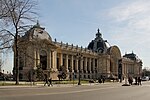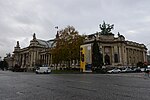International Exhibition of Modern Decorative and Industrial Arts

The International Exhibition of Modern Decorative and Industrial Arts (French: Exposition internationale des arts décoratifs et industriels modernes) was a World's fair held in Paris, France, from April to October 1925. It was designed by the French government to highlight the new style moderne of architecture, interior decoration, furniture, glass, jewelry and other decorative arts in Europe and throughout the world. Many ideas of the international avant-garde in the fields of architecture and applied arts were presented for the first time at the Exposition. The event took place between the esplanade of Les Invalides and the entrances of the Grand Palais and Petit Palais, and on both banks of the Seine. There were 15,000 exhibitors from twenty different countries, and it was visited by sixteen million people during its seven-month run. The Style Moderne presented at the Exposition later became known as "Art Deco", after the name of the Exposition.
Excerpt from the Wikipedia article International Exhibition of Modern Decorative and Industrial Arts (License: CC BY-SA 3.0, Authors, Images).International Exhibition of Modern Decorative and Industrial Arts
Port des Champs-Élysées, Paris 8th Arrondissement of Paris (Paris)
Geographical coordinates (GPS) Address Nearby Places Show on map
Geographical coordinates (GPS)
| Latitude | Longitude |
|---|---|
| N 48.8636 ° | E 2.3136 ° |
Address
Pont Alexandre III
Port des Champs-Élysées
75008 Paris, 8th Arrondissement of Paris (Paris)
Ile-de-France, France
Open on Google Maps









